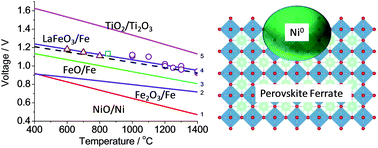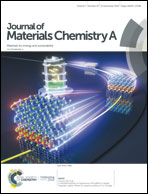A B-site doped perovskite ferrate as an efficient anode of a solid oxide fuel cell with in situ metal exsolution†
Abstract
Compared to a Ni(O) cermet, an oxide anode is much better for a solid oxide fuel cell at suppressing coking and carbon deposition from carbonaceous fuels. Furthermore, a small amount of metal nanoparticles can enhance the electrochemical performance of the oxide anode while maintaining compatibility with the carbonaceous fuel when anchored on the oxide surface. In this study, ferrate-based perovskites (La0.95Fe0.80Ni0.05Ti0.15O3, LFNT) with Ni0 particle exsolution are investigated via B-site doping to increase the stability at 800 °C in a H2 atmosphere and electrocatalytic capability for fuel oxidation. Surprisingly, the B-site doped LaFeO3 (La0.95Fe0.8Mg0.2O3, LFM) showed a high oxide-ion conductivity of 3.8 mS cm−1 with limited electronic conduction and further doping of Ti4+ or Ni2+ could increase the electronic conductivity to 30 S cm−1 and 100 S cm−1 at 800 °C for the reduced La0.95Fe0.8Mg0.05TiO3 (LFMT) and LFNT, respectively. The cell with the LFNT anode on a La0.9Sr0.1Ga0.8Mg0.2O2.85 electrolyte shows a polarisation resistance of 0.32 Ω cm2 at 800 °C, and a high power density of 600 mW cm−2 can be obtained when ceria is added via infiltration as a co-catalyst.



 Please wait while we load your content...
Please wait while we load your content...